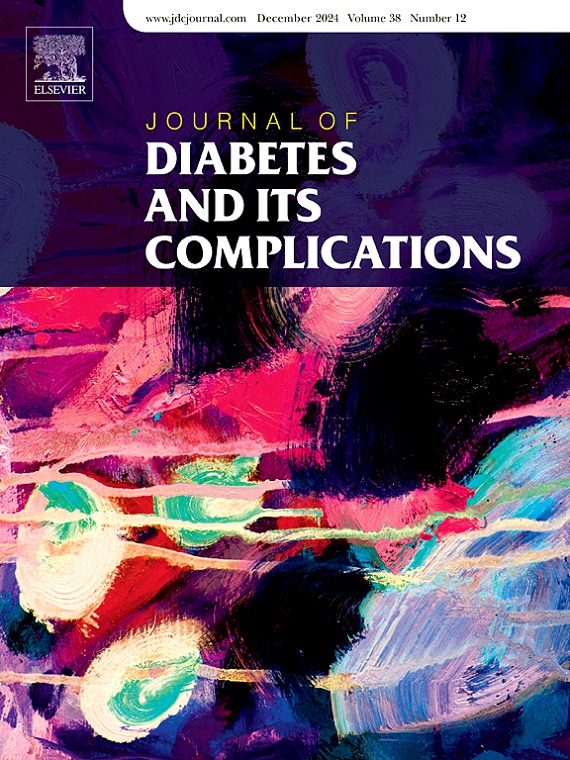Kidney fat by magnetic resonance spectroscopy in type 2 diabetes with chronic kidney disease
IF 3.1
3区 医学
Q3 ENDOCRINOLOGY & METABOLISM
引用次数: 0
Abstract
Background and hypothesis
The kidneys may be susceptible to ectopic fat and its lipotoxic effects, disposing them to chronic kidney disease (CKD) in type 2 diabetes (T2D). We investigated whether the kidney parenchyma fat content and kidney sinus fat volume would be higher in persons with T2D and CKD.
Methods
Cross-sectional study including 29 controls, 27 persons with T2D and no CKD, and 48 persons with T2D and early CKD (urine albumin creatinine ratio (UACR) ≥ 30 mg/g). Kidney parenchyma fat content and kidney sinus fat volume were assessed using magnetic resonance spectroscopy and Dixon scans respectively.
Results
In the control, T2D without CKD and T2D with CKD groups, respectively, median [1st – 3rd quartile] UACR was 5 [4 – 6], 6 [5 – 10] and 95 [43 – 278] mg/g. and mean ± standard deviation estimated glomerular filtration rate was 89 ± 11, 94 ± 11 and 77 ± 22 ml/min/1.73m2. Kidney parenchyma fat content was, respectively, 1.0 [0.5–2.4], 0.7 [0.2–1.2], 1.0 [0.3–2.0] % (p = 0.26). Kidney sinus fat volume was 2.8 [1.6–7.6], 8.0 [4.7–11.3], 10.3 [5.7–14.0] ml (p < 0.01). Around 90 % of T2D participants received a sodium-glucose cotransporter-2 inhibitor or glucagon-like peptide-1 receptor agonist.
Conclusions
In a setting of modern, multifactorial T2D management, kidney parenchyma fat content, evaluated with magnetic resonance spectroscopy, was similar among healthy controls and persons with T2D irrespective of CKD status. Still, kidney sinus fat volume was higher in the presence of T2D and higher still with CKD.
磁共振波谱分析2型糖尿病合并慢性肾病患者的肾脏脂肪。
背景和假设:2型糖尿病(T2D)患者的肾脏可能易受异位脂肪及其脂毒性作用的影响,从而导致慢性肾脏病(CKD)。我们研究了 T2D 和 CKD 患者的肾实质脂肪含量和肾窦脂肪体积是否会更高:方法:横断面研究,包括 29 名对照组、27 名 T2D 和无 CKD 患者,以及 48 名 T2D 和早期 CKD 患者(尿白蛋白肌酐比值 (UACR) ≥ 30 mg/g)。分别使用磁共振波谱和迪克森扫描评估肾脏实质脂肪含量和肾窦脂肪体积:对照组、无 CKD 的 T2D 组和有 CKD 的 T2D 组的 UACR 中位数[第 1 - 第 3 四分位数]分别为 5 [4 - 6]、6 [5 - 10] 和 95 [43 - 278] mg/g,估计肾小球滤过率的平均值(± 标准差)分别为 89 ± 11、94 ± 11 和 77 ± 22 ml/min/1.73m2。肾实质脂肪含量分别为 1.0 [0.5-2.4]、0.7 [0.2-1.2]、1.0 [0.3-2.0]%(p = 0.26)。肾窦脂肪量分别为 2.8 [1.6-7.6]、8.0 [4.7-11.3]、10.3 [5.7-14.0]毫升(p 结论:肾窦脂肪量的变化与肾脏的功能有关:在现代多因素 T2D 管理环境下,无论 CKD 状态如何,健康对照组和 T2D 患者的肾脏实质脂肪含量(通过磁共振波谱进行评估)相似。不过,患有 T2D 的肾窦脂肪量更高,而患有 CKD 的肾窦脂肪量更高。
本文章由计算机程序翻译,如有差异,请以英文原文为准。
求助全文
约1分钟内获得全文
求助全文
来源期刊

Journal of diabetes and its complications
医学-内分泌学与代谢
CiteScore
5.90
自引率
3.30%
发文量
153
审稿时长
16 days
期刊介绍:
Journal of Diabetes and Its Complications (JDC) is a journal for health care practitioners and researchers, that publishes original research about the pathogenesis, diagnosis and management of diabetes mellitus and its complications. JDC also publishes articles on physiological and molecular aspects of glucose homeostasis.
The primary purpose of JDC is to act as a source of information usable by diabetes practitioners and researchers to increase their knowledge about mechanisms of diabetes and complications development, and promote better management of people with diabetes who are at risk for those complications.
Manuscripts submitted to JDC can report any aspect of basic, translational or clinical research as well as epidemiology. Topics can range broadly from early prediabetes to late-stage complicated diabetes. Topics relevant to basic/translational reports include pancreatic islet dysfunction and insulin resistance, altered adipose tissue function in diabetes, altered neuronal control of glucose homeostasis and mechanisms of drug action. Topics relevant to diabetic complications include diabetic retinopathy, neuropathy and nephropathy; peripheral vascular disease and coronary heart disease; gastrointestinal disorders, renal failure and impotence; and hypertension and hyperlipidemia.
 求助内容:
求助内容: 应助结果提醒方式:
应助结果提醒方式:


